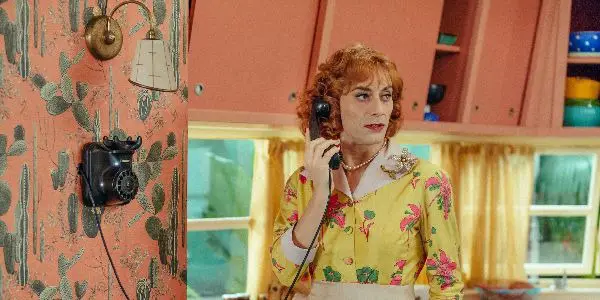An Italian language comedy-drama set in 1950s suburban America is not the first place you’d think to find an examination of trans identity. Sebastiano Mauri‘s new film Fairytale, based on the play written by his partner Filippo Timi, who stars in the central role, is a luridly-coloured and melodramatic exploration of the search for one’s own self in a world so rigidly functioning through the almost concrete gender roles of that time period.
Mrs. Fairytale (Timi), doting housewife of Stan (Sergio Albelli), lives a perfect life in her technicolour, suburban home – the monotony of her daily life interrupted by visits from her best friend Mrs. Emerald (Lucia Mascino), and the Stewart triplets Tim, Ted and Glen (Luca Pignagnoli) all of whom have a different relationship with Fairytale, for whom life is beginning to change in unexpected ways.
While there is undoubtedly a change taking place with Mrs. Fairytale, she is often far more interested in the ever-present threat of UFOs, dire warnings from her mother (Piera Degli Esposti) about the state of her marriage and the slowly uncoiling (if slightly daft) revenge she and Emerald plan to take out on their disloyal husbands.
An Uncanny Depiction of America
The first thing you notice about Fairytale is the set design. Fairytale’s house is a maze of bright pinks, yellows and blues, with different patterns of wallpaper decorating each room and the sleek modern architecture of a new-build in the 1950s. Curving, uneven arches lead between each room in the open-plan house while each room is filled with state of the art gadgets.

With the painted backdrops outside the windows, stylish and wonderfully camp dresses designed by Prada and Miu Miu design directors Fabio Zambernardi, Fairytale looks like something straight from the filmography of Doris Day and Rock Hudson – but there is an element of the uncanny that seeps through the perfectly designed house. It is never commented on or observed, but each window shows a different “typical” feature of American landscape: an autumnal suburb, a cactus-filled desert and a high-rise cityscape all simultaneously surrounding the house.
Another, and perhaps more obvious sign that Fairytale is not what it appears to be, is the fact that the entire dialogue is in Italian. This is a film firmly set in the time of rejuvenation and progress for US society, where big cars and bigger ambitions were vastly different to European and Italian society, who were still dealing with the economic consequences of World War II.
Uneven Comedy
Fairytale tries to balance a story of identity and transition with an odd, uneven comedic element that never truly seems to translate into actual humour, instead just becomes an off-putting element of this drama. Foremost in these excursions into the overly slapstick are any scenes involving the little white, and coincidentally stuffed, dog Lady, who has a habit of appearing and disappearing seeming of her own accord.
Mrs. Fairytale treats Lady like an extended member of the family, directing all her monologues towards her tiny animal, and Mauri cuts to the dog often, displaying her blank and unchanging reaction as a response to her owner’s ramblings. Whether it is the language barrier, or perhaps the translation from stage play to film, it doesn’t fully allow the more out-there comedic moments to find a footing – arguably one of the weaker aspects of Fairytale.
These attempts at comedy are heightened by the arrival of Pignagnoli’s characters, the three triplets with distinctive personalities and dress sense, as well as the “typical” monosyllabic names of the period: Tim, Ted and Glen. One is a studious and nervous type, one flirts outrageously and teaches the women to tango, and the other comes round to fix the boiler. All three of them place a tablet in Fairytale’s drinks – a subtle moment whose relevance is not revealed until the final act of the film.
Rather than a “black comedy” as it has been presented as, Fairytale‘s balance of reverence and pastiche of a Douglas Sirk film finds its strengths in the unique and interesting representations of settings and the gender roles of a 1950s film, rather than the comedy elements of those it takes reference from.
Life in Transition
There is an obsession with the physical in Fairytale, as Mrs. Fairytale tries to be the perfect housewife despite the changes taking place – portrayed in one moment as something from a horror film, backlit by the light of the moon and not much else as she gazes upon her reflection in the mirror. The thorny and violent relationship with Stan is not visualized, a lurking presence in the background as the friendship with Mrs. Emerald develops into more.
When all these different strands collide in the idealised life she has built in a society that was rigid and unmoving with regards to sexuality and gender – especially in the more staid suburbs of white America – the perfect world starts to bend and shift as the lines between reality and the imagination become ever more blurred.
Fairytale is an interesting take on the story of a transgender woman’s transition, set against the backdrop of external threats of UFOs, communism and a picture-perfect 1950s setting – although this might be the most memorable aspect of the film itself. With a blend of comedy, paranoia and beautiful gowns, it is an eye-catching film that sadly does not end up being much more than skin deep.
What are your favourite films that pay homage to the romcoms of the 1950s? Let us know in the comments below.
Does content like this matter to you?
Become a Member and support film journalism. Unlock access to all of Film Inquiry`s great articles. Join a community of like-minded readers who are passionate about cinema - get access to our private members Network, give back to independent filmmakers, and more.